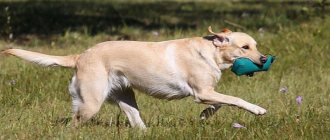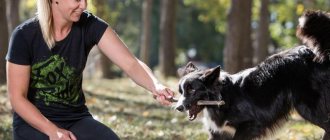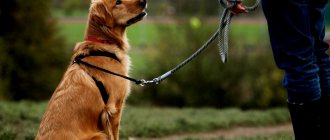Irina Ananchenko
According to veterinarians, every dog needs training in certain commands. Of course, for service dogs the list of required skills is strictly specified, but pets may only know a few commands, for example, “Fetch”, “Foo”, “Come to me”, etc.
Teaching your pet one or another “trick” allows you not only to diversify daily walks, but to develop obedience in the animal, correct perception of the world, and add physical activity, which will have a beneficial effect on health.
Don’t think that the “Fetch” command, familiar to many, is just a game for a dog. In fact, when a dog runs and gives an object on command, he develops a lot of useful skills that will be useful to him in the future.
Is it worth teaching your dog the “Fetch” command?
For those who are thinking about how to teach a dog to fetch a stick on command, but are afraid that the training will not give any results, I would like to give a little encouragement. With such activities, you develop your pet, allowing it to develop normally.
The dog learns:
- navigate the terrain and look for an object, which forces him to use his sense of smell and vision;
- think logically. That is, the owner gave an “order”, received what he asked for, he is satisfied;
- patience. An animal learns to run after a stick only with the permission of its owner;
- control emotions. A trained dog knows that no matter how much fun he may have playing with a stick, it must be returned to his owner.
According to experts, teaching the “trick” of returning a stick is very important for puppies that are characterized by excessive mobility, playfulness and aggression. It is necessary to teach the animal to concentrate on the object that is thrown to it. In this case, with strong emotional arousal or aggression, without receiving the “Fas” command, he will gnaw on the fetch object, and not on the intended enemy.
We teach the DOG to Fetch the BALL and the COMMAND GIVE
How to teach a dog to fetch a ball or stick thrown into the distance?
Why does a dog take the ball but not give it back? Let's talk about it in this video. I will tell you how I taught my dog to fetch a thrown object using the example of training my dog Gina. Date: 2017-10-19 Elli Di Pets
Rating: 4.5 out of 5 Votes: 2
Reviews for the video
1. Igor Katran I have an East European Shepherd. Almost two years old. Very smart. In 5-10 minutes he taught the commands to lie down, serve and voice. She understood the command to sit immediately when she was still a puppy. Brings the ball to the command “look for the ball” or something “Where is the ball?” She is now 1.7 years old. When she turns two years old, she will mate with a friend’s dog. We’ll probably keep one puppy and give the rest to friends.2. Polina You are the best video blogger in the world, I also have my own channel, it’s called Polina Simnikova, I love your videos and your training dog very much, soon my dad will buy me a dog ekrasel interest girl and I really want to have the same one a dog like yours, I even really want to name her Gina3. Miles Film Ellie you are the best channel in the world Can’t be described in words I will soon have a dog, and before that I had another one, but she was an ordinary mongrel, and I will have a purebred one (though I don’t know what breed) and I will need to train a puppy, but there are no normal channels with REALLY TRAINED DOGS. Ellie, you are just space. And you have the BEST Gina. I love you4. Polina Vishnya Hi Eli, I’m your subscriber, I’ve been watching your videos for 1 year and 6 months. Please make another video on how or just give me advice on how to persuade my mother to buy a dog. I’m trying to persuade you. I’ve already wanted a Jack Russell terrier many, many times. I want to name it Jessica if you If you help me, I will be very grateful to you5. Yum KeT what if my dog is not a fan of toys? The dog has a lot of toys, but she doesn’t play with anything (I’ve never seen her take a toy into her mouth. Is it possible to somehow accustom her to toys? She’s 6 months old.
tactics for training service dogs
If you do not plan to make your pet a service dog, then it is up to you to decide whether it needs to be taught the “Fetch” command or not. But if your pet is involved in rescue and search activities, then the animal will have to be taught such a “trick”. Such skills are included in the mandatory standard.
If the owner gives the dog the command “Fetch”, the dog must find the thrown object and return it. However, it is worth mentioning here that not every breed of dog likes such instructions. There are animals that fundamentally do not carry out “useless” commands. But even the most stubborn puppies enjoy playing with a stick or ball in the company of similar friends.
To facilitate the learning process, it is recommended to combine training with age-related changes in dogs. So, at the age of 3.5-4 months, puppies’ gums begin to itch and their teeth begin to change. This period is considered favorable for the beginning of the educational process.
If you want to start training earlier, then this is not prohibited, the main thing is that it brings joy to your four-legged friend and you.
Those who want to teach their pet to perform actions according to all the rules are recommended to adhere to the following scheme:
- the animal should position itself near the trainer on the left side near the leg;
- the stick is thrown forward, while the dog should not budge, but wait for instructions;
- the trainer says “Fetch”, on command the dog rushes for the stick;
- Having found the stick, the pet must return to its original position, going around the trainer behind him. At the same time, no gestures or sounds can be made;
- The dog must give the object to the trainer or place it on the ground after appropriate instructions.
Of course, this option looks boring and sad. It’s unlikely that anyone would want to train their four-legged friend like this. Therefore, the above scheme is suitable mainly for animals that will later become service dogs.
If you are going to throw a stick or ball to your pet just for fun and joy, then a softer method will suit you.
How to teach your dog to run after a stick yourself
So, if for you the “Fetch” command will only be a pleasant pastime, then the dog should be able to do the following:
- start searching for an abandoned item at your command;
- pick up a stick;
- return the returned item to you;
- perform all actions both on a leash and without it.
The training will take place in 3 stages. At the initial stage, you will need a stick and a positive attitude.
Let's look at the first stage, it can be practiced even with a tiny puppy:
- go outside with your pet on a leash;
- tease the dog with a stick, making sure it doesn’t grab it;
- throw the object no more than 2 m from your feet;
- if your pet showed interest in fetch and ran on its own, then that’s great. If not, then during the game, slightly pulling the animal, run towards the stick together;
- provoke the dog to pick up the fetch, if he doesn’t do this, then wait. As soon as the animal takes the stick in its mouth, say “Fetch”, the command must be given clearly and loudly.
Enough for the first stage of training. For now, it should be in your pet’s head that the word “Fetch” is permission to take the action “take an object that can be chewed.”
The subsequent stages are combined into one, since complex training will be required here. Otherwise, you will encounter a problem: your dog will not want to give up the stick and you will have to play “catch” with it. You need to exercise outside, while your pet is on a leash.
The procedure is as follows:
- starting position - dog at the foot, as if taking a position on the command “Place”;
- now throw the stick and say “Aport”. Even before the start of training, you must decide whether the puppy can immediately rush after the thing or only after a voice instruction;
- when your pet has picked up the fetch from the ground, begin to lightly pull the leash without saying anything;
- finish the exercise at your own discretion: sit the dog in front of you or near your left limb, remove the stick from its mouth.
Young and active puppies, having played out, may try to snatch an object from their hands and then begin to run away. Don't let your pet do this; regulate his behavior with a leash.
A pet dog is a true and devoted friend. But in order for him to be obedient, it is necessary to educate him. Moreover, you need to train your pet correctly. Otherwise, you can create negative associations with him that will worsen the relationship with the owner. Below we will tell you how to teach your dog the “Fetch!” command.
First you need to understand what “Aport!” is. for dogs. With this command, the owner gives his pet the order to fetch a previously thrown object and give it into his hands. It is believed that this skill can be mastered by representatives of any breed. But if you approach training incorrectly, the dog will refuse to perform the necessary actions in a certain sequence. Therefore, you need to make an effort so that your pet learns to carry out this command.
Teaching the command “Aport!” allows you to develop the following skills:
- search of the area and orientation in space. To complete the task, the animal uses hearing, smell, vision and all types of memory;
- drawing up logical chains, as well as developing conditioned reflexes. The dog learns to combine a voice command and a certain action;
- control of emotions and endurance. Necessary for returning the imported item to the owner;
- physical activity and exhaustion of the pet. Allows the animal to expend energy even with infrequent walks.
There are many benefits to executing this command. Thanks to her, the dog will always be in excellent physical shape, and the house will be clean and tidy.
How to teach your dog the command "Fetch the leash"?
This command contains several actions. First, the dog goes to look for its leash, then it must bring it to the owner. To make training go faster, it is advisable to always leave the leash in a certain place. Moreover, in such a way that the animal would have access. When the command “Give me the leash!” is heard, the dog follows the leash to the place where it is always located, takes it with its teeth or removes it from the hanger. After this, the pet gives the leash to the owner. Moreover, the dog must hold the leash until you take the leash from it. You should not allow your pet to throw its leash on the floor.
In addition, this command can be taught in reverse order. That is, in reverse order. The owner holds the leash in his hands, then gives it to the dog, and then takes it away. And this needs to be done several times. After that, the leash is taken into the room and the dog is sent to search for it. In any training, the pet must gradually move from ordinary, familiar commands to more complex ones.
Dogs will follow your commands without any problems if you praise them and treat them with various tasty “things.”
Recommendations for quickly teaching your dog the “Fetch the leash” command:
- — we call the dog, hand it a leash and invite it to take it and hold it with its teeth;
- — while the animal is holding the leash in its teeth, we move away from it a couple of steps. The pet must follow us, holding the leash, and not throw it to the ground;
- — put the leash on the ground and ask the dog to pick it up;
- - put the leash on the table, but do not praise the dog until he grabs the leash and heads in our direction;
- - put the item we need on the sofa and repeat our exercise again;
- — gradually we begin to put the leash where it is always stored;
- - change the command “Give” to “Leash”. We do this gradually. First we say “Give me the leash,” and then we leave only the second part of the command. That is - “Leash”.
Choosing a subject for training
To execute the command you need special equipment. The owner of the animal will throw the chosen item, and the pet will fetch it. The dog’s favorite toy can act as equipment. It is usually used at the very beginning of training to quickly create the required skill. It is best to choose sound toys. This could be a ball or a special toy (for example, a squeaking chicken).
Also used for training are rubber bones and special sticks, which are sold at any pet store. You can also take another suitable item: a regular stick, a plastic bottle with sand or cereal, a frisbee, a tennis ball. During the training process, you need to use the same toy so that the pet quickly gets used to the actions being performed.
When choosing a thing, you should understand that it should be safe for the dog, have a streamlined shape and light weight.
Do not use soft toys that get dirty very quickly, or objects that are so hard that they can damage your teeth.
Learning algorithm
Training should take place in a playful way. This will mean that the owner's behavior must meet certain requirements. For example, you should not shout or hit the dog - such actions will cause negative perception and lead to failure of education.
The easiest way to train a puppy. The older the animal gets, the more individual character traits it will develop, which are sometimes difficult to cope with. With melancholic and phlegmatic people you will have to work longer, and sometimes even cheat.
No matter what age and no matter what dog you have to work with, you need to understand that the training algorithm consists of three stages:
- “Take it!”;
- “Bring it!”;
- “Give it back!”
Let's look at each stage in more detail.
Take it
Training “Take it!” (as a separate skill) is performed only at the request of the owner. She will help train your pet to carry his leash or a bag of food on the way home from the supermarket.
The chosen retrieval item must be shown to the dog and teased. This will provoke the dog to grab the offered toy with its teeth. When grabbing, you should say “Take!” When the animal grabs the thing, you need to praise the pet and let him play with the toy for a while.
To quickly teach your dog this command, it is not recommended to give your pet the opportunity to “tear” the fetch toy. Otherwise, the coach will chase his ward to pick up the item.
When the pet learns to quickly pick up an item, it should be thrown to the side, gradually increasing the distance. In this case, the animal is always kept on a leash. If the dog has mastered this skill, you can move on to the next stage.
Bring it
Next, the pet learns the “Fetch!” skill. Here, too, you cannot give the animal the opportunity to tease its trainer. To do this, the dog must learn to control and pacify his emotions. You can't let your dog out early. She must receive a voice command and bring the fetch item to the trainer. Moreover, the pet should gradually learn to fetch an abandoned toy from an increasing distance.
When the animal grabs the toy, you must loudly say “Bring it!” At the same time, you can pat your knee with your hand. In the future, the dog must carry the object without a voice or visual command.
Give it back
At the last stage, the dog must give the trainer the toy he brought. To do this, when the animal approaches, you should clearly say “Give it back!” or “Give!” At the same time, you need to reach out and grab the retrieval item. At first you will have to hold the object for about 10-15 seconds. But then the dog will learn to fetch and return the toy without delays or additional voice commands.
Each time during the training process, when the pet performs an action correctly, it should be praised, stroked and given a treat. With this approach, the dog will quickly learn to perform the actions required of him. In the future, the dog can be taught other equally useful skills.
The command to fetch a stick, toy or some other object is perceived by many dog owners as pampering. But this is a very useful command that will help develop the dog’s search abilities in the future.
The third stage - completion of training
After the dog has learned to accurately choose the necessary thing among the rest, you can move on to the final stage. But this is done only after there were no errors in the sample, at least 5 lessons.
Now the animal is taught to sniff the hand of the main helper. The pet actively sniffs the hand three times, and after that, it is sent to the place where the sample items are located.
This is called bringing the conditioned reflex to a skill. If in the first two stages the conditioned reflex was reinforced in the animal, now it is turned into a skill.
After the dog has learned to work consistently without making mistakes, the rules change. Previously, the training took place on a calm, level area with a minimum of irritants. Now the dog must work in a completely different area. Things used to be in close proximity to each other. At the final stage of training, they are laid out randomly, at a sufficiently far distance.
How to interest a dog?
With the right approach to an animal, the “fetch” command can become his favorite command. An interested dog will be very happy to retrieve an abandoned object, even if it doesn't like it.
The main thing is that the dog gets as much exercise as possible, since almost all dog breeds are very active and love to frolic, playing with their owner on the street. When she gets rid of accumulated energy, she becomes calmer and more obedient, and also amenable to training.
This will help her develop physical fitness, which is very important for a good purebred dog.
Stages of training - features of training!
You can start teaching your puppy the “fetch” command at the age of one month. For such a small pet, training should take the form of a game, and after five months he will not only bring an object to the owner, but also sit near his left leg and hold it in his teeth for as long as necessary. The dog must give the item back after the command “give.” This is a good step for developing obedience in a dog and an excellent foundation for teaching more complex commands in the future.
To make it interesting for your puppy to learn the “fetch” command, you need to start playing with something he loves. For example, your favorite toy is a soft puller or any other. You can start training a small puppy at home, in the hallway, for example, but not in the kitchen, where there are a lot of distracting objects.
On the street during a walk, the puppy should play enough and grab the toy with its mouth. If he exhibits excessive passivity, the reason for this may be an unfamiliar area or poor artistic abilities of the owner. It is believed that children are the best motivators for dogs. They are just as active and even dance to attract the dog’s attention to themselves and their toys. Probably the laziest animal will start playing while watching such children.
You can throw a stick and kick it with your feet. The puppy should become interested and follow the owner, running after her. When he just grabs her with his mouth, it is recommended to wrestle with him, flirt with him and playfully tug at her. When this happens, you need to repeat the words “fetch, okay” from time to time.
We must not forget to praise the puppy every time, stroking it with your free hand as encouragement. In order to stop the fight and pick up the item, you need to say the command “give”, then repeat the game again.
The main goal is passion!
The owner's main goal is to develop the dog's passion for games. So, she will know that if she brings the thing, she will have the opportunity to have fun. This means that you must first flirt with the dog for a long time, and after some time it will begin to bring things. Thus, it is possible to achieve that the dog would rather refuse food than play with the owner.
How to teach to bring an object?
To do this you will have to wear a collar with a leash. Taking it by the very end, you need to throw the toy or stick at a distance of up to one and a half meters (no further is needed yet). When the dog runs up to the object and takes it into its mouth, you need to repeat the word “fetch” once and pull the leash.
The dog runs up to meet the owner, and he, in turn, grabs the object from the other side. So, a joint game begins with tugging and repeating the words “fetch, okay!” The game should last at least three to five minutes, more is possible.
It happens that the dog does not even want to run after the thing, let alone bring it. In this case, you need to arouse interest in it. During each walk, you must play and repeat “fetch, okay!”, otherwise nothing may work out.
If the dog runs up to the stick, but just stands near it, not paying attention to the commands, you will have to revive it a little. Move your foot and get the animal to take it in its mouth. When this happens, all that remains is to play with her.
When the dog starts to do everything correctly, runs after the stick, grabs it, you need to command “fetch”, pull the leash, play and be sure to praise, you can also reward it with a treat. After a few minutes, you need to throw the stick away again, saying “give.” If your dog is already losing interest, you can continue training the next day.
Over time, the dog will understand that bringing something to the owner is a very profitable business, because he can play after it or even receive a reward.
Difficulties in practicing the “fetch!” command
During the training process, the owner may encounter some difficulties. The speed of execution and the dog’s interest in the retrieving object depend largely on the individual temperament and inclinations of the animal. Melancholy pets, indifferent to active play, can work great at endurance, but are extremely reluctant to fetch. Temperamental, choleric dogs instantly bring a toy, but it is difficult for them to wait for permission to grab it, they are reluctant to give up the object. The owner must know the dog's personality in order to understand why the pet behaves this way.
- The dog constantly runs after a thrown object if it is not forcibly held by the collar. In this case, you can rein in the active dog by sharply pulling him by the leash and sternly pronouncing the command “near!” or “sit!” For large pets, you can use a strict collar. It is important to make a strong jerk and quickly sit the dog down at the moment of breakdown.
- After waiting for three seconds, the dog loses interest in the thrown toy. If this happens, the toy can be revived by pulling it a little by the rope. Moving a ball or squeaker will definitely arouse your pet's interest.
- The dog does not want to approach, making circles around the owner with a toy and inviting him to play. In this case, you need to throw the ball as close as possible and take the dog on a leash. Immediately after grabbing the ball, the pet is pulled towards the trainer, making sure to praise the dog at the same time.
- The dog throws the object, running up to the trainer. To prevent this, when your pet approaches, you need to hold the toy in its mouth, not allowing it to be thrown away. For some pets, just a gentle tug on the squeaker or wand is enough to get them to clench their teeth tightly. Some people have to hold their lower jaw until the command “give!”
- You can include the “fetch!” command in your training. an exercise that forces the dog to hold an object in its mouth until the command “give!” Having sat the dog next to him, a comfortable toy is placed behind his lower fangs and the command “hold!” is given. or “bring it!” In this case, the dog’s attempts to spit out the object should be stopped by lightly fixing the lower jaw.
The import item can be anything.
With regular lessons on practicing the command “fetch!” The pet will not only strictly follow the training course standards, but will also willingly carry a bag from the store or its own leash. If necessary, the owner can, without getting up from the couch, force the dog to bring any object located in the dog’s field of vision.
Working without a leash
When everything works out on a short leash, you can try training the dog on a long leash. The throwing distance increases by 2 meters, then each time the task becomes more difficult. This will take a lot of time, but it is necessary to achieve a distance of 5 meters and precise execution of the command.
The most common mistake dog owners make is demanding unquestioning dedication from the dog when the task becomes increasingly difficult. Everything should happen gradually. You should always praise the dog, treat it with a treat, and when it learns the “fetch” command, it will be ready to do everything without food - just for one kind word from the owner.
In the future, the “fetch” command will become the basis for learning to search on the ground, work on a trail, select a thing and protect it. If you don’t have time to train your purebred dog, then it is better to contact a professional trainer who will approach the training with knowledge.
During the training process, the dog and the owner must be in an aura of positive attitude; a kind word and decency of the trainer can work wonders! Your dog will very soon reciprocate your love and devotion!
When training a small puppy who is not yet able to hold toys tightly enough, it is recommended to use a piece of white or light-colored cloth tied in a knot. For older puppies, it is advisable to choose the most interesting toy.
The cloth is passed in front of the puppy's face, encouraging him to grab the cloth. Attempts to open the mouth and lick the fabric are encouraged verbally and with treats. Then they move the fabric a short distance, encouraging the baby to approach the object. At the same time, they are sure to praise.
When your pet picks up an object, you need to attract his attention and encourage him to return back with the object. To do this, call the pet to you, pronounce its name, and pat the floor with your palm. When the baby succeeds, enter the command “Bring it!” or “Aport!” The command is pronounced before throwing the object. After some time, the command is pronounced at the moment when the dog grabs the object.
Classes should be short - 5-10 minutes, and should be conducted in a quiet place. 2-4 repetitions per approach are enough. You should exercise at least 2 times a week.
Gradually the object is thrown to a greater distance. The distance is increased very slowly. If the object can no longer be reached with your hand, then use a long leash, with which you guide the dog when it needs to go back. When the pet has taken the object, carefully tighten the leash, letting the animal know where to go. They stop pulling on the leash as soon as the puppy turns in the right direction and begins to return.
If the animal does not bring the thrown object, there is no need to fuss and immediately run to pick it up. You should sit and wait patiently until the dog returns with the toy. Therefore, the distance is increased slowly. If the result cannot be achieved, then stop the lesson and try again later.
When the dog commands “Fetch!” brought an item, they command “Give!” and take the item, in return, treating the pet. If the animal does not give up the object, then use a treat that the pet cannot resist and will definitely release the toys from its mouth. It is not recommended to motivate the puppy to come back with another toy, although it is sometimes very effective. Some dogs, anticipating the throwing of another toy, release the first toy from their mouths without bringing it to the starting point.
Practice with frequent repetition and positive reinforcement will achieve the desired results. As the results improve, classes are held in different rooms, then outside. Gradually reduce the number of treats. The process of play itself should be a reward for the dog. And throwing a toy should motivate the animal to run after it and bring it back.
When the pet copes with the task, you can remove the leash and practice the command without it.
After working with the dog on the command “Fetch!” with a toy, you can complicate the task and teach your pet to fetch a stick, slippers, or any other objects. But before that, it is necessary to replenish the dog’s “vocabulary”. Study the names of the items so that your pet can understand which item needs to be brought. Next, the result is consolidated by sampling items. 3-4 objects are laid out in front of the animal and one specific object is named. If the pet chooses the named object, then you can proceed to practice the exercise of bringing this particular object.
How to teach a dog to fetch a stick: 10 ways
For such dogs, the only thing they need to be taught is the “Give” command. To train, simply bring a treat to your dog's nose while he is holding the toy and say the command. The dog will smell the treat and let go of the toy. Over time, she will associate the command with the action, and you will be able to take out and give her a piece AFTER she lets go of the toy. Or you can reward for giving not with a piece, but with a continuation of the game: “Give” - “Well done, grab.” The dog will learn that giving back a toy does not mean the end of the game.
But many dogs do not play in classes - they are either timid, distracted, or do not know how to play with their owners. Here's a quick guide to teaching your dog to play.
Goals
1.Improve the relationship with the owner by teaching the dog and owner interactive games. We are not trying to create a dog that likes to play with toys alone.
2.Improve the dog's attention and interest, as well as its physical fitness.
Rules
1. Start where your dog is calm and happy. Move to a new place when the dog already knows how to play perfectly.
2. Choose a time when the dog is happy and energetic. For many dogs, this is the time you come home from work. Not after you've gotten in, changed your clothes, and checked your email. Immediately upon your arrival, the dog is at its highest level of arousal of the entire day. Take five minutes to play right away. Keep toys in the car or in the hallway near the entrance.
3. Do not hug the dog, do not hold it in your arms, do not scratch or stroke it before playing.
4. Don't make cute faces at her or coo when you try to play with her. These are two incompatible types of behavior.
5. Stop playing before your dog loses interest or gets tired. Two minutes of intense play with pleasure is better than ten minutes where the energy and joy continually diminish in the last five minutes.
6. If the dog does not join the game after several attempts, do not whine or beg him. Lock her in a cage for a few minutes. This is not a punishment, you are simply showing your dog that the only kind of communication you are currently open to is play, and if he chooses not to play, you choose not to interact with him.
7. Don't leave toys for your dog when you're away. This includes playing with other dogs. If you want to build a love of playing with you, this should be the only time toys are available to the dog. You can later cancel this rule when the dog starts playing with you (this rule is more of a necessity for those dogs that play well on their own, but refuse to play with the owner)
Types of toys
1. The toy must be suitable for the dog. Small dog=small toy (in most cases); big dog=big toy. However, if you have a very soft, docile large dog, you may need a small, stuffed toy. If you have a crazy active Jack Russell, you may need a large and very durable toy.
2. Some dogs like to bite soft toys, some like harder ones. This does not apply to the size of the dog. Try different options to see what your dog likes best.
3. Change toys often - don't let your dog get stuck on one.
4. Place one or two toys around the house where the dog can see them but cannot reach them. Play with the toy yourself with a very interested look several times a day when the dog can see you but cannot approach you. Don't let your dog interact with you or a toy until he gets very excited watching you every day.
5. If your dog loves to eat, use a round container as a ball. Or take the stuffing out of a stuffed toy and fill it with treats. Use the food container as a toy. Tie the untanned leather onto a string and drag it along the ground for the dog to chase (just don't swing it in the air so you don't accidentally hit the dog).
Games without toys
Find out what your dog likes. If she backs away or shrinks, play softer. If she lies on her back, move away.
What to try
Gently pat the dog's sides with your palms
Push her away from you
Play tag by touching the dog's side and running away from it so that it catches up with you.
Grab the dog's paws (try all four)
Grab the dog by the tail (only if you cannot see the dog's eyes). Praise when the dog turns to you
Get down on the ground and play “bow” - tilt your head and lower yourself lower than the dog
Growl and bark at the dog
Games with toys
(use only after the above)
Rules:
1. Always show more attention, energy and enthusiasm to your dog when he has the toy. You don’t have to put a lot of effort into getting your dog interested in a toy only to immediately become cold when he finally takes the toy.
2. Don’t shake the toy in front of your dog’s face.
3. Dogs, being predators, prefer objects that move quickly away from them on the ground.
4. Tug is a fantastic game, encourage it more
5. Timid dogs will not take a toy if they think it is “yours.” Tie the toy to a rope so that there is some distance between you and the dog and the toy.
6. Don't hover over timid dogs or play face-to-face with them. Play “tug” and “chase” with your side to the dog.
7. Try hitting your dog on the side or back with a toy and quickly pull it away.
8. Alternate the non-toy games described above with toys to keep your dog interested in you.
9. In the early stages of learning to play, forget about control and obedience. Any interaction between you and the toy is great. Control will come after the dog loves to play. It's not difficult to add.
10. If your dog likes to tear soft toys, so be it, but only when playing with you. You can refill them several times, or use old socks and rags to stuff the toy each time you play.
11. If your dog grabs a toy and runs away with it, praise him as he grabs it, then turn your back to the dog and run away from him as quickly as possible. Most dogs will run after you. DO NOT try to catch the dog or take away the toy. When the dog catches up with you, praise him, turn around and run again. Repeat 3-4 times, then stop. If your dog approaches you with a toy, praise it and play “toyless” games without trying to take the toy from it.
Types of toys
Food toys for dogs who love to eat the most
-throw pieces to teach your dog to chase them
- fill a round container with food and throw it
- use a Kong toy (rubber with a hole) that you can fill with pate or cheese and throw
- take a soft toy and fill it with food
- take a sock and fill it with food
Pursuit toys
- anything tied to a rope
- balls rolling on the ground
– cat toys on “fishing rods” for small or timid dogs
Toys for stretching
- fleece
- socks
- rubber hoses
- towels
- ropes
Games
Chase the toy
— move the toy along the ground or pull it on a rope. Praise for any follow-through. Gradually start moving the toy faster and faster.
- bring the rapid movement of the toy to the stage of a short throw. If the dog chases even a little, praise it!
- remember, the dog is not obliged to pick up the toy at the beginning - any interest is happiness. When the dog understands that he is being rewarded for interacting with the toy, he will begin to do so more by touching and picking it up.
Importation
- take two identical toys. Play until the dog starts chasing the toy one and a half to two meters away from you and grabbing it
- as soon as the dog grabs the toy, tease it with a second one and throw it in the opposite direction. The dog will either run for a new toy without releasing the old one, or throw the first one and run for the second. Both are great!
- Play this back and forth game until the dog really starts to love it. Then start throwing the second toy only after the dog takes a few steps towards you with the first toy.
— Gradually increase the number of steps your dog has to take with the first toy before you throw the second one. Then throw the second one only after the dog gives you the first one.
"Stretch"
- play chase and don't let go of the toy or rope when the dog catches it. Praise for any time your dog holds the toy with you.
- lightly pull the toy and praise if the dog doesn’t let go
- Gradually increase the force with which you pull the toy, and praise the dog if he doesn’t let go
- try to trick your dog by pretending to grab his paws or pat his side while he pulls the toy
- the dog should like the game! Let Timid Dogs Beat You 75% of the Time
- to increase enthusiasm, steal the toy from the dog's mouth and have him jump after it and try to grab it (remember, we are trying to develop enthusiasm in the dog, not discipline - we will add that later). For every time you manage to snatch a toy from a dog, you must allow the dog to defeat you at least twice.
Learning
If all else fails, you can teach your dog to play like any command.
— teach your dog to touch the toy with its nose, encouraging it with a treat
- gradually demand more and more - instead of touching, the dog should already touch the toy with its teeth, then with its entire mouth
- then the dog will have to snatch the toy from you (hold it very loosely at first, but gradually strengthen your hold so that the dog has to grab the toy tightly) in order to earn a piece
- finally, teach your dog to bring you a toy to earn something tasty
- if you do this for a long time and for tasty food, the dog will get used to loving the toy and will work for it without a treat
Switching
- When the dog plays well with one or two toys, start “switching” him from one toy to another. Play fetch and praise your dog if he prefers the toy you are holding to the one in his mouth. Add new types of toys to this game.
— the dog must be taught to switch from working for food to working for a toy. Start by asking your dog to do simple exercises, reward him with treats, and then play.










